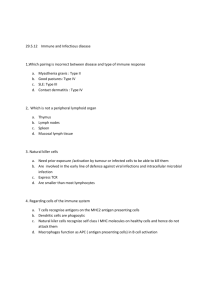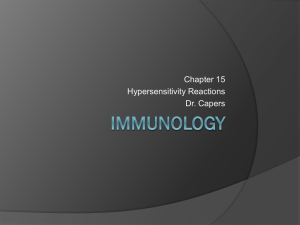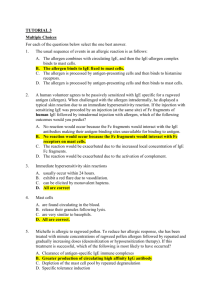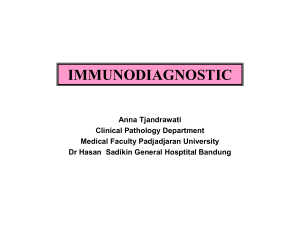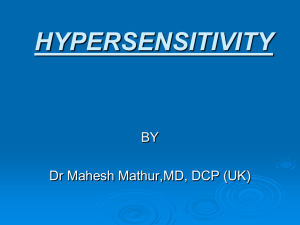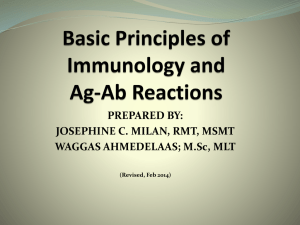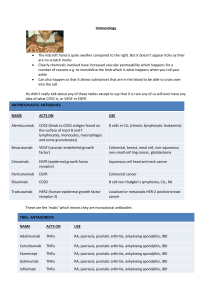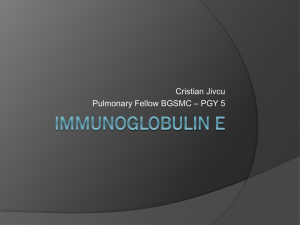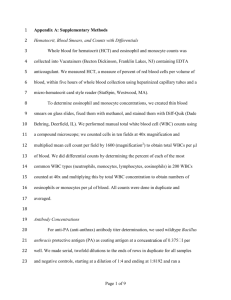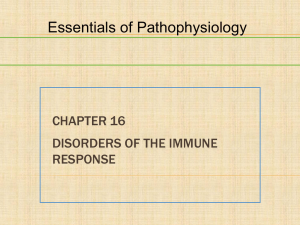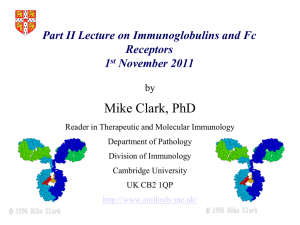Hypersensitivity
advertisement
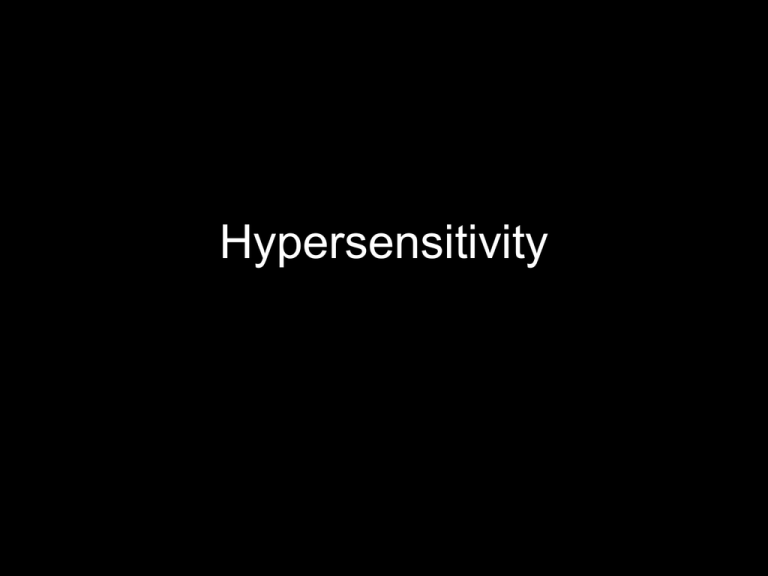
Hypersensitivity Hypersensitivity reactions • An immunological responses not controlled by normal regulatory mechanism. • Classification - Gell and Coombs system Gell and Coombs system • • • • Type I – immediate (Ig E) Type II – antibody mediated (ADCC) Type III – immune complex mediated Type IV – T cell mediated (delay type hypersensitivity) OUTLINE • Hypersensitivity -mechanism (Sensitization phase/Effect phase) -clinical manifestation -lab testing Type I - immediate hypersensitivity IgE-mediated reactions • Mechanism : FcεR On mast cells or basophils Soluble Antigen Cross linking of Fab degranulation Type I - immediate hypersensitivity IgE-mediated reactions • clinical manifestation Atopy: Genetically linkage -Allergies -Allergic rhinitis -Asthma -Atopic dermatitis 「濕疹」 異位性皮膚炎 -Allergic gastoenteropathy Lack genetic linkage and target organ : -Urticaria 蕁麻疹 -Anaphylaxis 全身性過敏反應 -Anaphylacic shock Allergic rhinitis Allergic rhinitis Type I - immediate hypersensitivity IgE-mediated reactions • allergen Host dust, arthropod, mold, weeds (ragweed), pollen, tree, animal, food, drug, latex Inhalant allergen Contact allergen Food allergen Type I - immediate hypersensitivity IgE-mediated reactions • Lab test Skin test In vitro tests Lymphocyte stimulation Intranasal provocative tests 鼻內激發法 Skin test • Cutaneous test (prick test) 扎刺法 pucture small amount to dermis and read after 20 min • Intradermal test 皮下過敏注射 semiquantitative In vitro tests 體外敏感試驗 • Total IgE : IMMULITE Total IgE (serum IgE only) • Allergen specific IgE RAST : radioallergosorbent test MAST : multiple antigen simultaneous test CAP Immunoblot (AlaBLOT test) --allergen: Ep strip • Eosinophilia : 114-142 300-500/mm3 • ECP (eosinophil cationic protein) 過敏原檢測 Total IgE Test CAP(混合過敏原群IgE抗體篩檢) Phadiatop, fx5 or CAP(特定過敏原IgE抗體篩檢, 自選) MAST allergy test MAST(Multiple Antigen Simultaneous Test) • 同時測定36種抗原 • 使用Chemical Luminescent ImmunoAssay • 半定量 Allergen + tested IgE → Allergen-IgE-(Anti-IgE) → CLA-1 ↑ Anti-IgE*Enzyme • 結果判讀 : 4 : >242 3 : 143~242 2 : 66~142 1 : 27~65 ±: 12~26 - : 0~11 (單位 : LUs) *Total IgE>500 IU/mL MAST中的 某些±可能為non-specific binding Principle • Chemiluminescence Analysis (化學冷光酵素免疫分析法) Allergen + tested IgE (待測血清) anti-IgE*enzyme Allergy-IgE-(anti-IgE*enzyme) photoreagent CLA-1儀器偵測 MAST allergy test • Introduction ─ 同時測定血清中36種過敏原的特異性IgE抗體 ─ 半定量計量。結果值(LUs淨值)以級數表示 • Result ─ 分四級:0, 0/1, 1, 2, 3, 4 ─ 2級以上表示有意義 • Clinical significance ─ Atopic allergy 屬第一型過敏反應。 ─常見的臨床症狀有花粉熱、氣喘、皮膚炎、蕁麻疹、過敏性休克 ─ 得知患者對不同過敏原的IgE濃度,是診斷和治療過敏的 重要資訊。 • MAST 36種過敏原測試 CAP cellulose carriers β-Galactosidase的抗IgE抗體 反應後,清洗掉未反應物, 加入反應呈色劑 於CAP機器判讀結果。 β-Galactosidase CAP • 吸入性混合過敏篩檢(23種)及食物性混合過 敏篩檢(6種) CAP • 吸入性混合過敏篩檢(23種)及食物性混合過 敏篩檢(6種) UniCAP UniCAP 原理: FEIA • Fluorescence Enzyme Immunoassay (FEIA) • Enzyme : β-galactocidase • Substrate : 4-MUG → 4-MU • Stop Solution : 4% Sodium Carbonate UniCAP • 以FEIA的方法,應用於Autoantibody(Specific IgG)和過敏免 疫系統(Total IgE, Specific IgE)的定量 • Total IgE 檢測體內所含IgE濃度,作為過敏的指標 ─ 測定範圍: 2~5000 kU/L • Specific IgE 檢測不同過敏原產生的特異性IgE抗體 ─ 吸入性混合過敏篩檢(23種)及食物性混合過敏篩檢(6種) Cyclic cirtullinared peptide(CCP) Ab Extractable Nuclear Antigen Ab(ENA) Eosinophil cationic protein(ECP) 將Anti-ECP固定於cellulose carriers(固相)中, 加入待測血清反應後,清洗掉未反應物,再加入 β-Galactosidase的抗ECP抗體反應後,清洗掉 未反應物,加入反應呈色劑於CAP機器判讀結果。 Anti-ECP 檢驗活化的eosinophil及其產物ECP可追蹤病程,並在 發炎期(ex.急性氣喘)給予抗發炎藥劑,降低發炎,故 檢驗血清中的ECP值是治療成效的指標。 Type I - immediate hypersensitivity IgE-mediated reactions Therapy • Environmental measures : avoid allergen • pharmacological therapies -antihistamine -corticosteroids -cromolyn sodium • Desensitization treatment -Allergen shots (blocking antibody, IgG) • Antibody against free and membrane IgE • Antibody to CD23 (low affinity IgE receptor) • Cytokine intervention IgG IgM Type II – antibody mediated • Mechanism : Sensitization phase 1.Cell surface antigen Transplanted cell Host cell (autoimmune) Foreign antigen bind to host cells Ag dose not clear from system 2.IgM IgG production (dep. on cytokine) Effect phase 1.Complement activation chemoattractant C5a C3a Anaphylatoxin C5a Opsonin MAC 2.ADCC by NK 3.Opsonin mediated phagocytosis Destory cells IgG IgM Type II – antibody mediated • clinical manifestation (dep. on cell type) -Hemolytic disease of newborn -Transfusion reactions -Autoimmune disorders -Drug induced reactions -Transplantation Hemolytic disease of newborn RBC-Rh antigen Autoimmune disorder • Goodpasture’s syndrome Ab against kidney and lung basement membranes Antiglomerular basement membrane antibody (Anti-GBM) renal biopsy even layer on the glomerular basement membrane • Myasthenia gravis Ab against acetylcholine receptor in neuromuscular junctions down regulation of receptors by endocytosis muscle weakness Drug induced reactions ex : penicillin Drug (hapten) Bind to cell surface Type II hypersensitivity Cell destruction IgG Type III-immune complex mediated IgM • Mechanism : Sensitization phase 1.Chronic Ag (soluble) exposure autoimmue disorders or persistent infection 2.IgM IgG production (dep. on cytokine) Too many immune complexes for phagocytes to remove Immune complex formation and deposition in the capillary walls IgG Type III-immune complex mediated IgM Effect phase 1.Complement Anaphylatoxin Opsonin chemoattractant C5a C3b CR1 C5a C3a 2.Neutrophil phagocytosis damage capillary walls (proteolytic enzyme) 3.Coagulation Vascular permeability PLA aggregation blood clot formation * 4.Immune complexes penetrate and lodged in capillary walls 5.Vascular occlusion Type III-immune complex mediated • clinical manifestation -SLE autoantibody, immune complexes deposit in various tissues -Post streptococccal glomerulonephritis S. pyogenes, kidney, “captured antigen” -Serum sickness passive immunization of non human IgG human antibody – non human IgG (ex:horse serum:anti-diphtheria antibodies, antiserum administered following a snakebite ) -Farmer’s lung Ag = spore of Thermophilic actnomycetes -Arthus Reaction Serum sickness Arthus Reaction • Ag inject into immunized body • Local inflammatory response due to deposition of immune complexes in tissues. • vaccine boosting(第2劑) Detection of Immune Complex • C1q binding assay • Raji cell assay • Detection of Cryoglobulins C1q binding assay C1q binding assay False (-) Small immune complex、 IgE, IgA, IgG4 immune complex False (+) Fibrinogen、fibronectin、DNA、 endotoxin、heparin Raji cell assay • Lymphoblastoid cell line from Burkitt’s lymphoma • C1q C3b C3d and Fcg receptor • Normal:<15.0 μgEq/mL • positive: 20.0μg Eq/mL Raji cell assay • False-positives occur when antilymphocyte antibodies are present. • Especially in SLE, positive results often reflect the presence of lymphocyte antibodies. • Raji assay are commonly found in systemic necrotizing vasculitis and might be useful for monitoring sarcoidosis(肉狀 瘤病). Detection of Cryoglobulins • Cryoglobulins are abnormal immunoglobulins which form complexes and precipitate out of serum at low temperatures and resolubilise on warming. • 4oC沉澱,加溫溶解 • responsible for specific symptoms,such as Raynaud’s phenomenon, vascular purpura, bleeding tendencies, cold-induced urticaria http://www.labcorp.com/datasets/labcorp/html/chapter/mono/sc029100.htm Detection of Cryoglobulins Immunochemical Composition Type of Cryoglobulin Type 1 : Single monoclonal immunoglobulins • • • • Type II : Mixed monoclonal immunoglobulins • IgM-IgG • IgG-IgG • IgA-IgG Type III : Mixed polyclonal immunoglobulins • IgM-IgG • IgM-IgG-IgA IgM IgG IgA Monoclonal light-chains Detection of Cryoglobulins Type 1 : Single monoclonal • immunoglobulins • • Myeloma Waldenstrom’s Chronic Lymphocytic Type II : Mixed monoclonal • immunoglobulins • • • Myeloma Waldenstrom’s Macroglobulinaemia Chronic Lymphatic Leukaemia Type III : Mixed polyclonal immunoglobulins • • • • • • • • • • Autoimmune Disease: Lupus (SLE) Rheumatoid arthritis Scleroderma Sjogren’s Syndrome Chronic active hepatitis Active Hepatitis. Post streptococcal nephritis. Vasculitis Infections: Type IV – T cell mediated delayed-type hypersensitivity, DTH Sensitization phase Effect phase Type IV – T cell mediated macrophage activation • clinical manifestation chronic DTH -Mycobacterium tuberculosis acute DTH (24-48 hr.) -Mantoux skin test (PPD= purified protein derivative) Contact dermatitis Mycobacterium tuberculosis TB prevent fusion of lysosomes and phagosomes TB live in macrophage macrophage destruction chemotatic factors release chemotasis 聚集形成 肉芽(Tubercle,結核) 乾酪樣壞死 Type IV – T cell mediated • Lab patch test (read after 48 hr.): PPD or tuberculin skin test (Koch phenomena) Candida albicans Streptokinase Mumps Trichophyton The DTH skin test: Mantoux test • Determine the infection of Mycobacterium tuberculosis (PPD= purified protein derivative) PPD summary Type I Immediate Type II Ab mediated Type III Immune complex mediated Type IV Cell mediated Soluble Antigen Cell surface Antigen Soluble Antigen (many) Effect phase Sensitization phase IgE IgE crosslinked with Ag Mast cells and basophils degranulation Allergies Rhinitis Asthma Anaphylaxis Anaphylacic shock Urticaria Hemolytic disease of newborn Goodpasture’s syndrome Myasthenia gravis Drug induced reaction Transfusion reaction Transplantation SLE Post streptococccal glomerulonephritis Serum sickness Persistent infection Farmer’s lung IgM IgG Ab bind to surface Ag *Complement *ADCC by NK *phagocytosis (Opsonin) cell destruction IgM IgG Ab bind to free Ag immune complex Immune complex deposited in capillary wall localized destruction Naïve CD4 T cell activation Clinical Macrophage DTH Contact sensitivity Delay hypersensitivity Immunity to viral and fungal antigens and intracellular organisms Rejection of foreign tissue grafts Elimination of tumor cells bearing neoantigens Formation of chronic granulomas Comparison of Different Types of hypersensitivity characteristics type-I (anaphylactic) type-II (cytotoxic) type-III type-IV (immune complex) (delayed type) antibody IgE IgG, IgM IgG, IgM None antigen exogenous cell surface soluble tissues & organs response time 15-30 minutes minutes-hours 3-8 hours 48-72 hours appearance weal & flare lysis and necrosis erythema and edema, necrosis erythema and induration histology basophils and eosinophil antibody and complement complement and neutrophils monocytes and lymphocytes transferred with antibody antibody antibody T-cells allergic asthma, hay fever erythroblastosis fetalis, Goodpasture's nephritis SLE, farmer's lung disease tuberculin test, poison ivy, granuloma examples
